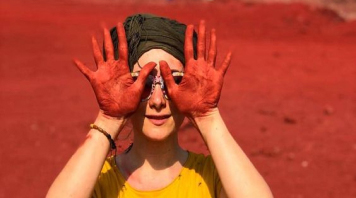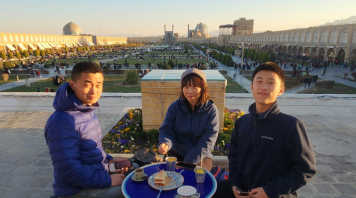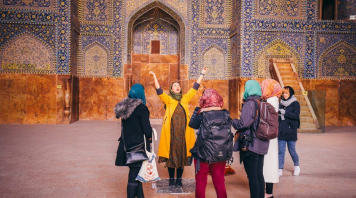The Lut Desert, also known as Dasht-e Lut, is one of the hottest and driest places on Earth, located in southeastern Iran. This vast desert, recognized as a UNESCO World Heritage site, is famous for its extreme temperatures, unique landforms, and stunning scenery.
With sand dunes that seem to stretch endlessly and towering rock formations shaped by centuries of wind erosion, Dasht-e Lut shows nature’s raw power and beauty. Let’s explore its geography, climate, and what makes it an unforgettable destination for adventurous travelers.
Lut Desert in Kerman, the Hottest Place on Earth
The Lut Desert is a natural wonder situated mostly within Kerman Province in southeastern Iran. Covering around 51,800 square kilometers, it’s one of the largest deserts in the world and holds the record for some of the highest surface temperatures ever recorded, sometimes exceeding 70°C (158°F).
The desert is divided into three main regions: a northern zone with vast salt flats, a central area with towering sand dunes and unique rock formations, and a southern part with wind-sculpted ridges and steep valleys. Here is a table with general facts about the Dasht-e Lut:
| Feature | Details |
| Location | Southeastern Iran (mainly Kerman Province) |
| Area | Approximately 51,800 square kilometers (20,000 square miles) |
| UNESCO Status | World Heritage Site since 2016 |
| Estimated Age | Millions of years, with geological formations shaped over millennia |
| Temperature Records | Surface temperatures can exceed 70°C (158°F), among the highest recorded on Earth |
| Climate | Extremely arid; very little to no rainfall annually |
| Elevation | Ranges from salt flats at sea level to dunes and ridges over 1,000 meters (3,280 feet) |
| Geological Features | Yardangs (sand ridges), sand dunes, salt flats, rock formations, and dry riverbeds |
| Flora and Fauna | Very sparse due to harsh conditions; some adapted plants and small animals |
| Unique Aspect | Known for yardangs—wind-carved ridges resembling a “moonscape” |
| Accessibility | Remote; access generally requires guided tours from cities like Kerman |
Unique Geological Formations
The Lut Desert is filled with striking geological formations, including the famous “yardangs” or sand ridges that create an almost alien landscape. These structures have been shaped over millennia by harsh winds, resulting in dramatic and surreal scenes that attract photographers, geologists, and adventurous travelers from around the world.
Location of Lut Desert
Dasht-e Lut is located in southeastern Iran, spanning the provinces of Kerman and Sistan-Baluchestan. This vast desert stretches approximately 480 kilometers (300 miles) from northwest to southeast and around 320 kilometers (200 miles) from east to west. While much of the desert falls within Kerman Province, it also extends into parts of South Khorasan and Sistan-Baluchestan provinces.
You can check out our Kerman travel guide to find out more about Dasht-e Lut and other Kerman attractions.
Lut Desert Photos
Accommodations in the Lut Desert
Accommodations in the Lut Desert are limited due to its remote location and extreme climate, but travelers can still find options, especially near the desert’s edges in Kerman Province. Here are some of the main options:
- Eco-Lodges and Guesthouses: Several eco-lodges and traditional guesthouses are located in small villages surrounding the desert, such as Shahdad and Mahan. These accommodations provide a more authentic experience, often offering traditional Iranian meals, basic amenities, and guided tours to explore the desert safely.
- Camping: For adventurers who prefer an immersive desert experience, camping is possible but should be done with caution. It is recommended to camp with an organized tour or local guide to ensure safety, as the desert’s extreme heat and lack of resources make independent camping challenging.
- Hotels in Kerman: Kerman offers a range of hotels from budget to luxury options. From Kerman, travelers can take day trips to the Lut Desert with guided tours that cover transportation, food, and safety essentials.
Best Time to Visit Lut Desert
The best time to visit Dasht-e Lut is from October to April when temperatures are cooler and more comfortable for exploring.
October and November offer warm days and cool nights, while December to February is the coolest period, with mild days and cold nights. March and April bring rising temperatures but remain bearable, especially in the morning and afternoon.
Avoid the extreme summer months (May to September), when temperatures can soar above 50°C (122°F), making travel conditions hazardous.
Conclusion
From its record-breaking temperatures to unique geological formations, the Lut Desert in southeastern Iran is an awe-inspiring environment unlike any other. Whether you’re drawn to its dramatic sand dunes, wind-sculpted ridges, or simply the adventure of exploring one of Earth’s harshest terrains, the Lut Desert can provide an unforgettable experience.







